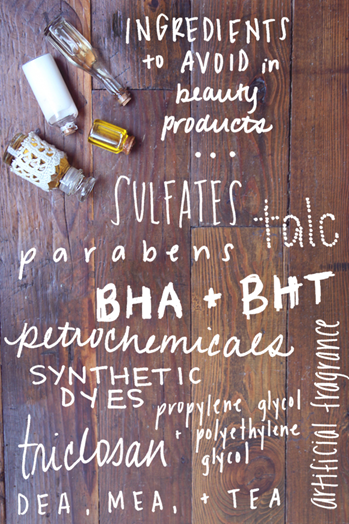Welcome to this week’s JoLynne Shane.
This week I’m sharing ingredients to avoid in beauty products from Dr. Susan Stuart a board certified dermatologist from La Jolla, California.

As our body’s largest organ, skin is the most important immune defense barrier as well as your largest organ for eliminating waste. Every day we use products that we think are safe but not all products are. Ever since 1938; when the FDA granted self-regulation to the cosmetics industry such products can be marketed without government approval of ingredients, regardless of what tests show.
Most of the 25,000 chemicals used have not been tested for long-term toxic effects. In a typical day, you might be exposed to over 200 different chemicals, many of which are suspected of causing cancer or juggling hormones. EPA tests conclude that ingredients in shampoos, dyes, and other personal care products “may be playing havoc with hormones that control reproduction and development.”
Parabens
Used in a variety of cosmetics as preservatives. Suspected endocrine disrupters and may interfere with male reproductive functions.
Parfum (a.k.a. fragrance)
Any mixture of fragrance ingredients used in a variety of cosmetics — even in some products marketed as “unscented.” Some fragrance ingredients can trigger allergies and asthma. Some linked to cancer and neurotoxicity.
Alcohol, Isopropyl (SD-40):
A very drying and irritating solvent and dehydrator that strips your skin’s moisture and natural immune barrier, making you more venerable to bacteria, molds and viruses. It is made from propylene, a petroleum derivative and is found in many skin and hair products, fragrance, antibacterial hand washes as well as shellac and antifreeze. It can act as a “carrier” accelerating the penetration of other harmful chemicals into your skin. It may promote brown spots and premature aging of skin. A Consumer’s Dictionary of Cosmetic Ingredients says it may cause headaches, flushing, dizziness, mental depression, nausea, vomiting, narcosis, anesthesia, and coma. Fatal ingested dose is one ounce or less.
DEA (diethanolamine), MEA (Monoethanolamine) & TEA (triethanolamine):
Hormone-disrupting chemicals that can form cancer-causing nitrates and nitrosamines. These chemicals are already restricted in Europe due to known carcinogenic effects. In the United States however, they are still used despite the fact that Americans may be exposed to them 10-20 times per day with products such as shampoos, shaving creams and bubble baths.
Mineral Oil:
Petroleum by-product that coats the skin like plastic, clogging the pores. Interferes with skin’s ability to eliminate toxins, promoting acne and other disorders. Slows down skin function and cell development, resulting in premature aging. Used in many products such as baby oil which is 100% mineral oil!
Sunscreen Chemicals:
These chemicals function as a sunscreen agent, to absorb ultraviolet light. These chemicals are endocrine disruptors and are believed to be easily absorbed into the body. They may also cause cellular damage and cancer in the body. Common names are benzophenone, PABA, avobenzone, homosalate and ethoxycinnmate. They can be found in sunscreen products.
Talc:
Similar to asbestos in composition, it’s found in baby powder, eye shadow, blush, deodorant. Linked to ovarian cancer and respiratory problems.
Toluene:
Known to disrupt the immune and endocrine systems, and fetal development, it’s used in nail and hair products. Often hidden under fragrance.
Propylene glycol:
Propylene glycol is a small organic alcohol commonly used as a skin-conditioning agent. It’s classified as a skin irritant and penetrator. It has been associated with causing dermatitis as well as hives in humans — these sensitization effects can be manifested at propylene glycol concentrations as low as 2 percent. It can be found in moisturizers, sunscreen, makeup products, conditioners, shampoo and hair sprays.
Sodium Lauryl Sulfate (SLS) & Sodium Laureth Sulfate (SLES):
Detergents and surfactants that pose serious health threats. Used in car washes, garage floor cleaners and engine degreasers – and in 90% of personal-care products that foam. Animals exposed to SLS experience eye damage, depression, labored breathing, diarrhea, severe skin irritation, and even death. Young eyes may not develop properly if exposed to SLS because proteins are dissolved. SLS may also damage the skins immune system by causing layers to separate and inflame.
This week Janise is hosting the link up. Don’t forget to enter for a chance to win our October giveaway – products from derma-e You can enter using the Rafflecopter widget below.


